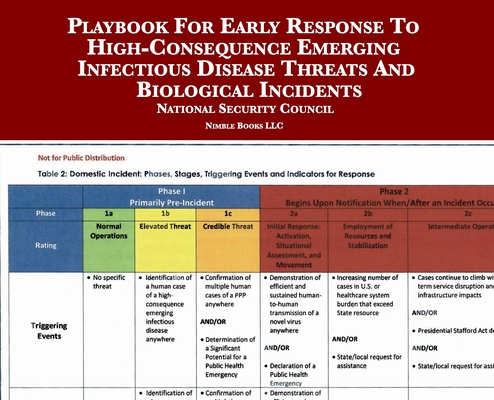Playbook For Early Response To High-Consequence Emerging Infectious Disease Threats And Biological Incidents

Playbook For Early Response To High-Consequence Emerging Infectious Disease Threats And Biological Incidents
The Playbook describes itself as follows: "a decision-making tool that identifies: (1) questions to ask; (2) agency counterparts to consult for answers to each; and (3) key decisions which may require deliberation through the Presidential Policy Directive (PPD)-1 process or its successor National Security Council process." This is a document with an optimistic view of its role in the world. It is not clear that policy leaders in any Administration are actually interested in outsourcing their decision-making to a tool developed by a previous admninistration. To the contrary, policy-makers typically place a great deal of emphasis on getting their own people in place to ask the right questions.
The main body of the Playbook is comprised of two major sections, one for international events that have not yet reached the US and one for events with a US locus. For each, a "Rubric" is provided that "is not intended to serve as a comprehensive concept of operations or replace national or pre-existing U.S. Government response structures, but rather to serve as a proposed guide based on existing authorities, guidance, and response frameworks for staff monitoring emerging infectious disease threats and interagency planning and response, should the need arise in the future." The key words are "for staff monitoring emerging infectious disease threats..." -- in other words, this document was intended for use by staff who are monitoring things, rather than for policy makers who are deciding them.
The Rubrics explicitly spell out key assumptions--for example, on the domestic side that "the U.S. Government will use all powers at its disposal to prevent, slow, or mitigate the spread of an emerging infectious disease threat..." The drafters did not include any language such as "unless it might hurt the stock market." Both Rubrics contain exhaustive lists of important questions and decisions that correspond well with what we know now to have been important in the res
PRP: 223.12 Lei
Acesta este Prețul Recomandat de Producător. Prețul de vânzare al produsului este afișat mai jos.
178.50Lei
178.50Lei
223.12 LeiIndisponibil
Descrierea produsului
The Playbook describes itself as follows: "a decision-making tool that identifies: (1) questions to ask; (2) agency counterparts to consult for answers to each; and (3) key decisions which may require deliberation through the Presidential Policy Directive (PPD)-1 process or its successor National Security Council process." This is a document with an optimistic view of its role in the world. It is not clear that policy leaders in any Administration are actually interested in outsourcing their decision-making to a tool developed by a previous admninistration. To the contrary, policy-makers typically place a great deal of emphasis on getting their own people in place to ask the right questions.
The main body of the Playbook is comprised of two major sections, one for international events that have not yet reached the US and one for events with a US locus. For each, a "Rubric" is provided that "is not intended to serve as a comprehensive concept of operations or replace national or pre-existing U.S. Government response structures, but rather to serve as a proposed guide based on existing authorities, guidance, and response frameworks for staff monitoring emerging infectious disease threats and interagency planning and response, should the need arise in the future." The key words are "for staff monitoring emerging infectious disease threats..." -- in other words, this document was intended for use by staff who are monitoring things, rather than for policy makers who are deciding them.
The Rubrics explicitly spell out key assumptions--for example, on the domestic side that "the U.S. Government will use all powers at its disposal to prevent, slow, or mitigate the spread of an emerging infectious disease threat..." The drafters did not include any language such as "unless it might hurt the stock market." Both Rubrics contain exhaustive lists of important questions and decisions that correspond well with what we know now to have been important in the res
Detaliile produsului









